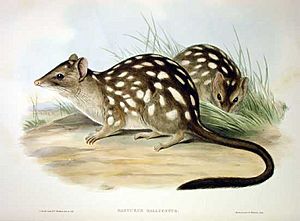Northern quoll facts for kids
Quick facts for kids Northern quoll |
|
|---|---|
 |
|
| In Queensland, Australia | |
| Conservation status | |
| Scientific classification | |
| Genus: |
Dasyurus
|
| Species: |
hallucatus
|
 |
|
| Northern quoll range | |
The northern quoll (Dasyurus hallucatus) is a meat-eating marsupial that lives in Australia. It is also known by other names like the northern native cat or satanellus. Indigenous people have their own names for it, such as njanmak in the Mayali language, djabo in Kunwinjku, and wijingarri in Wunambal.
The Kunwinjku people of Western Arnhem Land think of the djabo as "good tucker," meaning it's good to eat.
Contents
What is a Northern Quoll?
The northern quoll belongs to a family of animals called Dasyuridae. Scientists first described this animal in 1842. It was named hallucatus because it has a special first toe. Sometimes, this quoll has been placed in its own group called Satanellus.
Life and Habits of the Quoll
The northern quoll is the smallest of the four quoll species found in Australia. Female quolls are smaller than males. Adult females usually weigh between 350 and 690 grams. Adult males are heavier, weighing from 540 to 1120 grams. Their body length, not including the tail, ranges from about 25 to 37 centimeters. Their tails can be between 20 and 34 centimeters long.
What Northern Quolls Eat
Northern quolls mostly eat small creatures without backbones, like insects. But they also enjoy fruits, especially figs. They hunt and eat many different animals with backbones, such as small mammals, birds, lizards, snakes, and frogs. You might even see them eating animals that have been hit by cars or looking for food around campsites and in garbage bins.
Unique Life Cycle of Males
One very interesting thing about northern quolls is that the males usually die after they mate. This means the female quolls are left to raise their young all by themselves. Female quolls have eight teats inside a pouch. They often give birth to more than eight babies. These tiny babies must then race to the pouch and compete to find a teat to survive.
How Long Quolls Live
In the wild, male northern quolls typically live for only about one year. Female quolls can live a bit longer, up to about three years. If quolls live in rocky areas, they might live for two or three years, and they can grow larger. This is probably because rocky habitats offer better protection and less danger from predators.
Where Northern Quolls Live
Northern quolls can be found in different parts of Australia. Their home stretches from the Pilbara region in Western Australia, across the Northern Territory, and into southeastern Queensland. In the past, they lived all the way from Queensland to the Kimberleys in Western Australia without any breaks. Now, their populations are split up into several separate groups. These quolls prefer to live in rocky areas and open forests with eucalyptus trees.
Protecting the Northern Quoll

The northern quoll is currently listed as an endangered species. This means it is at a high risk of disappearing forever.
They are no longer found in many places where they used to live, especially in the savanna areas. In 2005, the Australian government also listed them as Endangered.
Dangers to Quolls
Many things threaten the northern quoll:
- Predators: Wild cats, dingoes, and foxes hunt quolls. This is especially a problem after fires or grazing remove the plants that quolls use for cover.
- Habitat Loss: Their homes are being destroyed or damaged by land clearing, grazing animals, and mining.
- Roads: Quolls can also get hit by cars on roads.
The Cane Toad Threat
The biggest danger to northern quolls in the northern and western parts of their home is the spread of cane toads. Like many other native Australian animals, northern quolls get poisoned if they try to eat or even lick a cane toad. Cane toads were brought to Queensland a long time ago. Now, they have spread across the Northern Territory, including Kakadu National Park, and into Western Australia.
When cane toads arrived in Kakadu, many quolls died out very quickly. However, some quoll groups in Queensland have lived with cane toads for decades. These quolls seem to have learned to avoid the toads naturally. Scientists have even found that some quolls in Kakadu survived the toad invasion, possibly because they were also naturally able to avoid the toads.
Helping Quolls Survive
To help protect northern quolls, some were moved to islands without cane toads, like Astell and Pobassoo Islands. The quolls did very well on these islands. Later, some of these island quolls were brought back to Kakadu National Park. Scientists tried to teach them to avoid cane toads before releasing them.
However, even with training, these quolls faced new challenges. They had lost some of their natural skills to avoid predators like dingoes and cats, which they had not encountered on the islands. This shows how important it is for animals to keep their natural survival skills.
Images for kids
See also
 In Spanish: Satanelo septentrional para niños
In Spanish: Satanelo septentrional para niños






